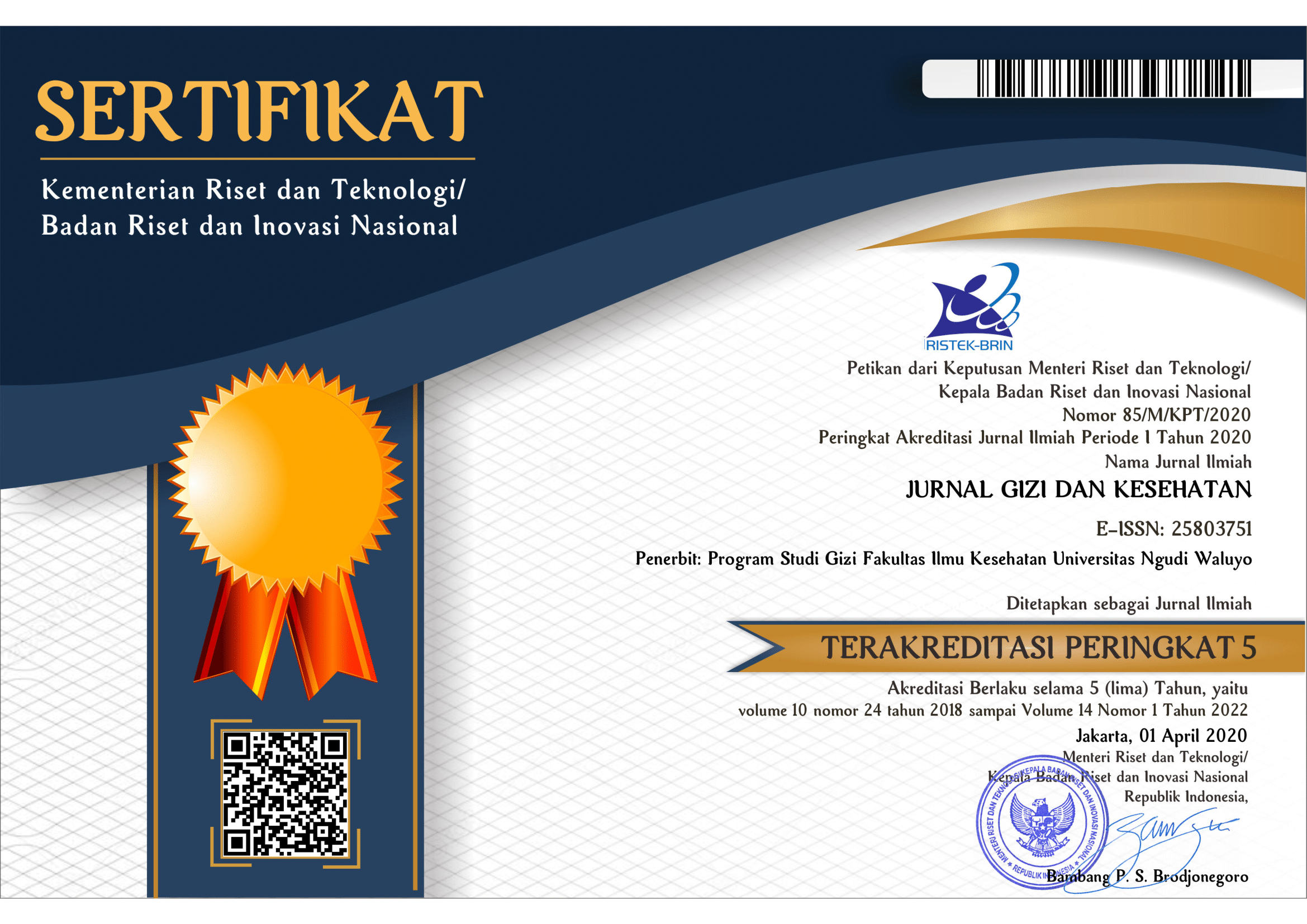Factors Related To The Event Of Less Nutrition In Children Age 37-59 Months In The Center Of Public Health In Kaubele District Biboki Moenleu North Central Timor Regency
DOI:
https://doi.org/10.35473/jgk.v13i1.106Keywords:
Intake of energi and protein, The Diarrhea, MalnutritionAbstract
Malnutrition problems in children under five can be influenced by energy intake, protein intake and the incidence of diarrhea. The purpose of the study was a factors associated with the incident of malnutrition in children aged 37-59 months at The Center Of Public Health Kaubele Moenleu Biboki District North Central Timor Regency.This study was a correlation descriptive study with a cross sectional approach. The sample consisted of 78 toddlers at the Kaubele The Center Of Public Health, Biboki Moenleu District, North Central Timor Regency, taken by proportional random sampling technique. Data collection instrument using secondary data from weighing results, kueisoner, form SFFQ. Data analysis using chi-square (α = 0.05). The result of this study indicated that there were intake energy good 8 toddlers ( 10.3 % ) , energy less 70 toddlers ( 89.7 % ); protein intake more 2 toddlers ( 2.6 % ) , protein good 32 toddlers ( 41.0 % ) , less 44 toddlers ( 56.4 % ); toddlers who do not diarrhea 36 toddlers ( 46.2 % ) , diarrhea 42 toddlers ( 53.8 % ); toddlers normal weight of 30 toddlers ( 38.5 % ) , toddlers weight less 48 toddlers ( 61.5 % ); There is correlation between intake energy , protein intake and the chain diarrhea with the genesis malnutrition in toddlers ( p = 0.025, p = 0.002 and p = 0.000 ). There is correlation between intake energy , protein intake and the chain diarrhea with the genesis malnutrition in toddlers 37-59 months in The Center Of Public Health Kaubele Biboki Moenleu District North Central Timor Regency.
Downloads
References
Hapsari, S. (2012). "Determinant Factors of Incidence of Undernutrition of Children aged 2-5 Years in Pulutan Village, Sidorejo District, Salatiga City. (https: // scientific publication .ums.ac.id._ accessed 17 September 2020). "
Rahim F. (2014). "Risk Factors for Underweight Toddlers Age 7-59 Months". Journal of Public Health, 9 (2): 115-121.
Rosari, A., RiniE.A., & Masrul. (2013). "The relationship between diarrhea and nutritional status of children under five in Lubuk Crocodile Village, Koto Tangah Subdistrict, Padang City".http://jurnal.fk.unand.ac.id/index.php/jka/article/view/138. Downloaded February 12, 2020.
Septiari, B. (2012). Printing Smart Toddler and Parenting Patterns. Yogyakarta: Nuha Medika.
Sodiaoetama A. (2008). Nutrition Science for Students and Nutrition Professions in Indonesia. Bharata Karya Aksara, Jakarta.
Subagyo, Bambang and Nurtjahjo Budi Santoso. (2012). Acute diarrhea. In Mohammad Juffie et al, Gastroenterology-Hepatology Textbook. Jakarta: Indonesian Pediatric Association.
Shukla, Y .et al., (2016). “Risk factors for Severe Malnutrition in Under Five Children Admitted to Nutritional Rehabilitation Centre : A Case-Control Study from Central India”. International Journal of Community Medicine and Public Health, 3(1), pp. 121-127.
Wong, H. J., Moy, F. M. & Nair, S. (2014) “Risk factors of Malnutition among Preschool Children in Terengganu, Malaysia: A Case Control Study”. BioMed Central Public Health, 14(785), pp. 1-10.










